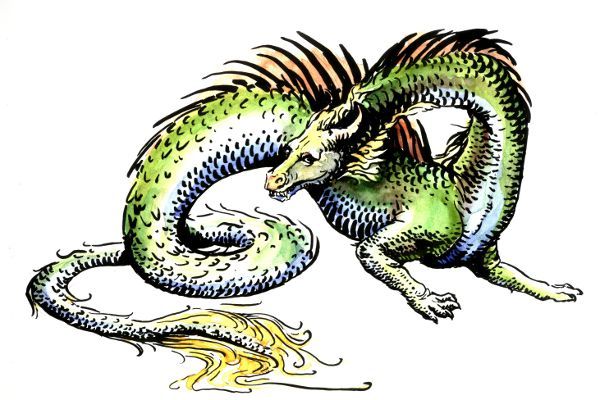Majestic Creatures Profile
Lindworm
Lindworm

Statistics
Habitat: Akasuna, Southern Savannah
Dimensions: can become quite enormous, a single pair of limbs, a long tail, and has no wings
Diet: Carnivore
Rated Danger Level: 5
Colour: scales of brown, green or gold to blend into the savannah.
Beast Tamer:
Dimensions: can become quite enormous, a single pair of limbs, a long tail, and has no wings
Diet: Carnivore
Rated Danger Level: 5
Colour: scales of brown, green or gold to blend into the savannah.
Beast Tamer:
Lindworm
s have extremely high intelligence. They are capable of human speech, writing and some suspect they can perform magic. This makes them incapable of taming as a pet.Lindworm
Norse Mythology
Lindworm
, Linnormr or Lindwyrm as a concept originally were found in Old Norse and Germanic mythology. There are variations of Scandinavian folk tales that speak of the Prince Lindworm, born from a woman who asked a witch for help to bear children.Lindworm
s are highly prominent throughout Norse mythology. Nidhogg is a lindworm dragon who lives by the roots of Yggdrasil, the famous ash tree that holds all the Norse realms together in its branches. Nidhogg continuously chews the roots hoping to one day destroy it. Fafnir was a dwarf cursed by Andvari’s ring, forced to transform into a Lindworm and later slain by a Norse hero. The Lindworm features in some runic inscriptions uprooted in Scandinavia as relics of Norse mythology.Lindworms in Norse Mythology usually appear without any limbs at all.
Chinese Mythology
The
Akasuna Lindworms potentially combined the mythology of "The dragon king" and "Fuxi". The Dragon King is known for their intellegence and could appear as humans. Fuxi, the son of the Chinese Dragon, closely resembles the shape of the Akasuna Lindworm and is the most "dragon-like". Fuxi is usually found across stone tablets.
Lindworm
s on World of Legends take partial inspiration from ancient chinese dragons, mainly for their colourful scales and movement. Chinese dragon mythology depicted dragons as beautiful and powerful creatures that blessed the seas, lakes and rivers.Akasuna Lindworms potentially combined the mythology of "The dragon king" and "Fuxi". The Dragon King is known for their intellegence and could appear as humans. Fuxi, the son of the Chinese Dragon, closely resembles the shape of the Akasuna Lindworm and is the most "dragon-like". Fuxi is usually found across stone tablets.
Lindworm
Mythology in World of Legends

The following is an extract from Morrigan Darkwaters book, "Dragons of Islendor":
"The world of academics is split in the middle on whether we can consider the Akashi
The Akashi
Usually, their scales have the colours of their surroundings, so they are green, brown and so on. They are extremely intelligent creatures, which is another feature that works in favour of them being true dragons. They are able to use human speech and they can write and create art with their two limbs. Moreover, even if this is still debated, they are believed to be able to perform earth magic and, in fact, they live in tunnels they excavate in the savannah.
A legend that was found in very ancient scripts in Akasuna tells about a golden
Still, the presence of this legend makes us ask something: is it true that all the ancestral dragons had four limbs and a pair of wings, or could there be other types of dragons, whose fossils are not here for us to find? We will probably never know."
"The world of academics is split in the middle on whether we can consider the Akashi
lindworm
a true dragon or not. The reason for this is quite simple: the lindworm deviates quite a bit from the ancestral draconic body that we can still see well preserved in the sand dragon. In fact, the lindworm only has a single pair of limbs, a long tail, and has no wings at all. That being said, it still shares many anatomical and physiological features with the ancestral dragons, so much so that I, in my humble knowledge, consider them to be dragons that adapted to a new environment and evolved to their new shape during the ages they spent in this new continent.The Akashi
lindworm
, while still being rare, is one of the most common dragons of Isilendor and the most common in Akasuna, more so than the sand dragon. This is due to the fact that it inhabits a much easier habitat: the southern savannah. In fact, it can also be seen in the north of Braitheld occasionally.Usually, their scales have the colours of their surroundings, so they are green, brown and so on. They are extremely intelligent creatures, which is another feature that works in favour of them being true dragons. They are able to use human speech and they can write and create art with their two limbs. Moreover, even if this is still debated, they are believed to be able to perform earth magic and, in fact, they live in tunnels they excavate in the savannah.
A legend that was found in very ancient scripts in Akasuna tells about a golden
lindworm
, enormous in size and almost blinding for how magnificent it was. It is said that it had great wisdom and that it was the one who taught humans how to write. To these days, sometimes there are still people who insist on having seen golden lindworms, but it is much more likely for them to be just regular lindworms whose scales are in the colour of dry yellow grass.Still, the presence of this legend makes us ask something: is it true that all the ancestral dragons had four limbs and a pair of wings, or could there be other types of dragons, whose fossils are not here for us to find? We will probably never know."
What Do You Think of Lindworms?
For more detailed sources of information, see the following links: https://worldoflegend.eu/library/1174b187-5e15-4abd-bedb-92a52ca60e0c
https://mythus.fandom.com/wiki/Linnormr
https://mythus.fandom.com/wiki/N%C3%AD%C3%B0h%C3%B6ggr
https://mythus.fandom.com/wiki/F%C3%A1fnir
https://www.chinahighlights.com/travelguide/article-chinese-dragons.htm
https://mythus.fandom.com/wiki/Linnormr
https://mythus.fandom.com/wiki/N%C3%AD%C3%B0h%C3%B6ggr
https://mythus.fandom.com/wiki/F%C3%A1fnir
https://www.chinahighlights.com/travelguide/article-chinese-dragons.htm

